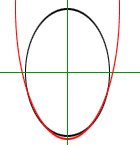My students had a question for me today in C30 that I wasn't sure about so they suggested that I write to you. We are studying systems of equations where two conic sections are the two equations that we are solving simultaneously. We were studying the number of solutions that are possible if you have an ellipse and a parabola. We all agree that there can be none, one, two, three or four solutions. The question that the students had for me was whether or not a portion of an ellipse and a parabola can overlap and thereby allow an infinite number of solutions. What should I tell them?
Glenda
Hi Glenda,
This is a nice question. Your statement that "that there
can be none, one, two, three or four solutions" lists all possible situations.
Here is an algebraic argument for the situation in the diagram below.
(An egg in a parabolic bowl.)

To make the equation easy, I put the ellipse in standard position, that is the centre at (0,0) and the axes along the X and Y axes. Thus the equation of the ellipse has the form
The equation of the parabola can be written
More generally, any conic satisfies an equation of the form
If you know five points on the conic then substitute in the five (x, y) pairs and you get five linear equations in five unknowns. As I recall, this system of equations will always have a unique solution. This means that if "two" conics have five points in common then they are actually the same conic. Thus two different conics can share at most four points.
Chris and Harley